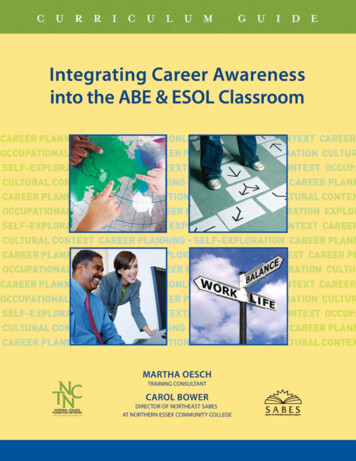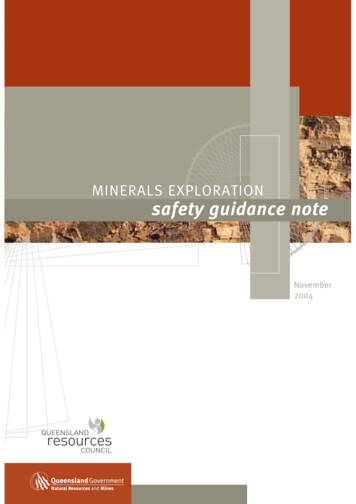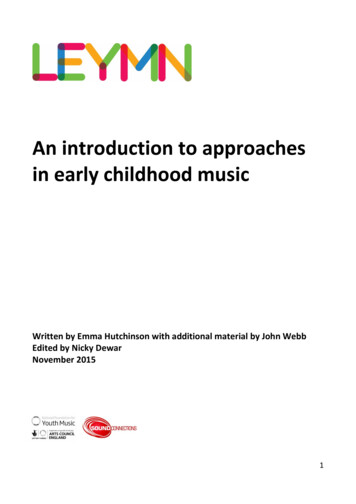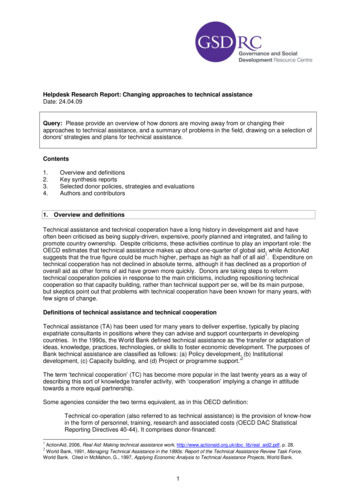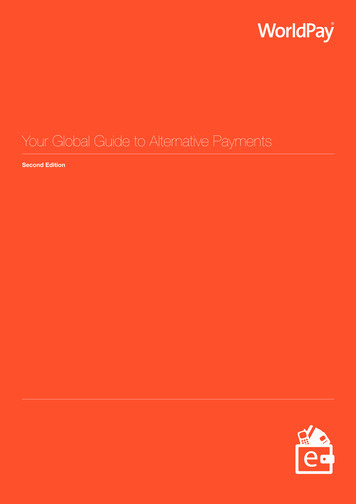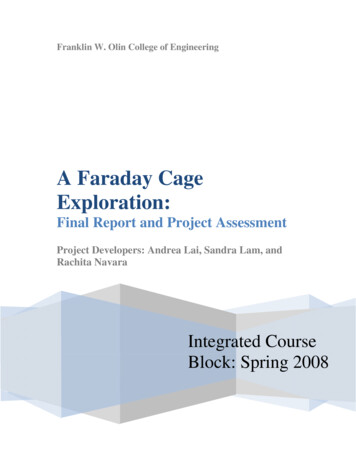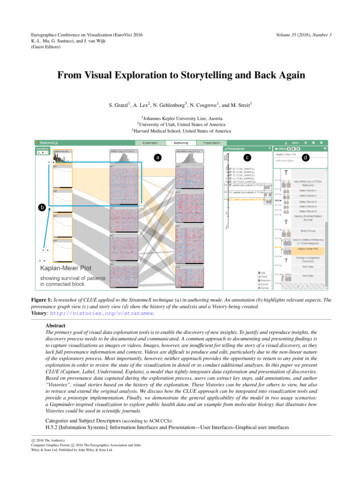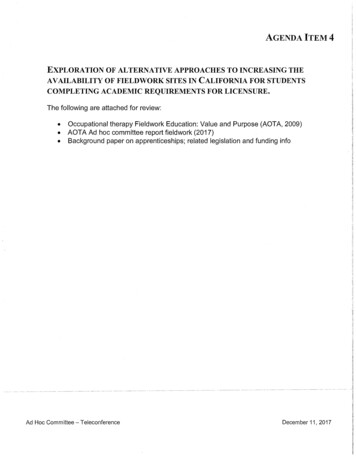
Transcription
AGENDA ITEM 4EXPLORATION OF ALTERNATIVE APPROACHES TO INCREASING THEAVAILABILITY OF FIELDWORK SITES IN CALIFORNIA FOR STUDENTSCOMPLETING ACADEMIC REQUIREMENTS FOR LICENSURE.The following are attached for review: Occupational therapy Fieldwork Education: Value and Purpose (AOTA, 2009)AOTA Ad hoc committee report fieldwork (2017)Background paper on apprenticeships; related legislation and funding infoAd Hoc Committee - TeleconferenceDecember 11, 2017
OcCtlpatibhEd'1'h,etapY ·.!," i:',; , .(. ofFieltiwo'r,l(':Ediic'ation:\'\!alue 'and'Plifpose""" ."The purpose of fieldwork education is to propel each generation of occupational therapy practitioners from !J lt ; J \ Pt::; : t f; ;; K :!1 ;! J!s: c 1 :!:: meet the occupational needs of a diverse client population. Fieldwork assignments may occJii:hl ·\rariety. ,'9fpi'il ti,, , A EllgsJincWdirm11is.fliCal;edtii;atiQn91, mclcClmnwni'!y QasedJ? ams;Morepveri ieldwork: .,. :,. ,.,. . ,."pl%y w ntEl;Rl g, prE! er;tt,Jhe 9Pp,orh,tI;rity JQ,w,tJ::ccltl e, RG pation "tl:lE FEj,PY .erxigeA to new.E)Jtg, :t:'gingpractice environments.,',, ,f):,:: ,.F, E7l4}Y:t;wk; ? iS1lme,1}t S8n ,ti.f;l,ltE!, Cffi.tn,tegr:al P . of hePS9FPa,tiQ;1N,fueI:ClPY aJ} :l pq:upation,ct} j:heri:1pyaS is.t@t:eP4CqHQnJur icul,a . ThrQN,gh#eldw,ork/ Eltude,p:t; leamtpa.pply theoretif,a). d;;sc:jelltificprinaple lea ned fro their academic programs to ddress actual client needs within the context ofauthentic practice environments. Whpe on fielciwo k, ,e'.lchstudent deve ops cOrn,Petency to a ertain clientotcllpirtiori: l p Tfbrfuan2e 'h'eeas'tdid iitify·'si.ipPdrtSot·b,ar# rS'; # #ng:heliltf1-'andp tH, {pati()ii' ddocument interventions provided. Fieldwork also provide 'bpp8rhiriitr id 't'he:ghl(feIl.ttbCtleveiopaclV:O,qwy, )e?clersWp,andmanagerial skills in,avariely 9f pracl;j.c; ,Setting:'l.Finally,the. st\ldentdevelops aprofessional identity as an occupational therapy practitioner/aligning his or her professional judgmentsand decisions with the American Occupational Therapy Association (AOTA) Standards ofPractice (AOTA,2005b) and the Occupational Therapy Code of Ethics (AOTA, 2005a).",, r?,,:,·,·:,,: :,·'j;', . '· .I· "":': . ". ,:, ;. ' -. .: . .': r"'"{ - . .:. . ,.:;. :: :; .:. .-.: . {:.(., . ,.':?;: . : . ;. '.'i .;. . . . ;.": . ;: :. : . . . As students proceed through their fieldwork assignments, peiform:anceexp qa,jioU '1: e :;9!tleprogJ:essively. :. "k .:' :more challenging. Level I fieldwork experiences occur concurrently with acacie,mr.c: cq t§ y,9 1(ari: .ai "designed to enrich didactic coursework through directed observati()!1, C!psip # ip 6.h U W: d: pec!s .,of the occupational therapy process" (Accreditation Council fo!' b·cC1.rpat ()h (lh r pyi, Sl.u ion.1".,::. :. . ;: . .;;,.[ACOTE], 2007a, 2007b, 2007c). Level II fieldwork experiences occur at or near the, qh 1 i9nof tP.eJ;licl dicphase of occupational therapy curricula and are designed to dev lqp.c?I:)1p t;:e t i *- !;:' ei ,stpractitioners (ACOTE, 2007a, 2007b, 2007c). Level II fieldwork assignments featUrefA q,epth' '&PerH e(s)in delivering occupational therapy services to clients, focusing on the applicatI6ri,p P 4t o :tii' dmeaningful occupation and evidence-based practice through exposu,re ,t,?,a "yaret§;o(CIieIl 'aa sWWii espan and to a variety of settings" (ACOTE, 2007a, 2007JJ, 20,9 : ',:d':" ;!"iJ: ;;h ·'';''V.'' "t;',,,,,, ,.) ;. 'i, ;;, '; . ; r ';.:.,.:;. :-. - :,. :. (: . ,.,.:::, ,' . .: ,: . , ." .r . ' .,.,." "-'A,,!.! . ,.The value of fieldwork transcends the obvious benefits directed toward the student. Supervising studentsenhances fieldwork educators' own professional develQPm :ntlJyproy cUngexposuretQ! rentprac:ticetrends, evidence-based practice, and research. Moreover, the experience of field work supervision is recog nize PY, the,NatiqnalBpaJ,"dfor,C rMci;ltion in OccupatioI1al,;I'herapy JNBCQT)andmany stateregulatqryboards as a legitimate venue for achieving continuing competency requirements for occupational therapypractitioners .,;: . ;. :.:.::: . . .,,:. :, :.( . , ,.:. :.:." ': ': .: ,. . .-' . , . '. .:.::.',. . : ! .: .'., . :-,-. .; :.'.;:' ":J .:{. '.:-.:- ::.:, . :. '; " . ' . '. " I : .::. . ;. ; :: .;".: . ··;·f . ;.!.:.;.' . . ., .::::.,.,.,. r ··. ·, :. . . ,.:. .: .Another 'beneflt to the fieldwork site for sponsormg a neldwork. eB tio Pt? 'W':i 'WiQ:t,fu ,i t,n,t tof qualified occupational therapy personnel. Through the responsibilities expected during Level ITfieldwork, occupational therapy staff and administration are given opportunity for an in-depth view of astudent's potential as a future employee. In turn, an active fieldwork program allows the student, as a393
THE REFERENCE MANUAL OF THE OFFICIAL DOCUMENTS OF THE AMERICAN OCCUPATIONAL THERAPY ASSOCIATION, INC.potential employee, to view first-hand the agency's commitment to the professional growth of its occupa tional therapy personnel and to determine the "fit" of his or her professional goals with agency goals. Thefieldwork program also creates a progressive, state-of-the-art image to the professional community,consumers, and other external audiences through its partnership with the academic programs.In summary, fieldwork education is an essential bridge between academic education and authentic occupa tional therapy practice. Through the collaboration between academic faculty and fieldwork educators,students are given the opportunity to achieve the competencies necessary to meet the present and futureoccupational needs of individuals, groups, and indeed, society as a whole.ReferencesAccreditatioIlJ:;ouncil for Occupational Therapy Education. (2007a). Accreditation standards for a doctoral degree level educational program for the occupational therapist. American Journal ofOccupational Therapy,61,641-651.Accreditation-Council for-Occupational Therapy Education (2007b) Accreditationstandards for a master's degree level educational program for the occupational therapiSt. American Journal ofOccupational Therapy,61, 662-671.Accreditation Council for Occupational Therapy Education. (2007c) Accreditation standards for an educa tional program for the occupational therapy assistant. American Journal of Occupational Therapy, 61,652-661.American Occupational'rherapy Association. (2005a). Occupational therapy code of ethics (2005). AmericanJournal pf Occupational Therapy, 59,639-642.American Occupational Therapy Association. (2005b). Standards of practice for occupational therapy.American Journal of Occupational Therapy, 59, 663-665.The Commission on EducationRenePadilla, PhD, OTR/L, FAOTA,ChairpersonAnd a BWcs,PhD; OTR/LJudithC.B1um,.MS,QIR/L .Paula C. Bohr, PhD, OTR/L, FAOTAJ nillfer C. Coyne, COTA/LJyothi Gupta, PhD, OTR/LLinda Musselman, PhD, OTR, FAOTALmda Orr, MPA, OIR/LAbbey SIppI ASD LiaisonPatricia Stutz-Tanenbaum, MS, OIRNeil Harvison, PhD, OTR/L, AOTA Staff LiaisonAdopted by the Representative Assembly 2009FebCS115This document replaces the document The Purpose and Value of Occupational Therapy Fieldwork Education2003M41.Copyright 2009, by the American Occupational Therapy Association. To be published in the American Journal ofOccupational Therapy, 63(November/December).394
IntroductionAt its November 4-5, 2016, meeting, the AOTA Board of Directors reviewed the many complexchallenges facing the viability of the existing fieldwork and other experiential components ofoccupational therapy education programs for occupational therapists and occupational therapyassistants. The Board voted to establish an Ad Hoc Committee to explore current experientialrequirements in occupational therapy education and alternative models that would best ensurefuture entry-level practitioners are prepared to meet occupational needs of society.AOTA convened an Ad Hoc Committee for a 2-day, face-to-face meeting in Bethesda, MD, onFebruary 6-7, 2017.At its February 17-18, 2017, meeting, the AOTA Board of Directors reviewed the report of the AdHoc Committee. After considerable discussion and questions, the Board of Directors voted to takethe following actions:1. Moved to accept the Fieldwork (Experiential) Ad Hoc Committee's report to the AOTA Boardof Directors as written.2. Charged the AOTA President to write to the ACOTE Education Standards Review Committee(ESRC) endorsing the Ad Hoc Committee's recommendation to change the current LevellFieldwork Standards to reflect the Ad Hoc Committee's recommendations for the "InitialExperiential Learning Requirement" in the 2017 Standards as outlined in the report.3. Charged the AOTA Executive Director to develop a report for the AOTA Board of Directors'October 2017 meeting detailing the potential impact and costs of implementing theproposed model for experiential learning that includes a post-graduate residency forgraduates of entry-level programs for occupational therapists. The report should include, butnot be limited to,1. Costs and timeline for advocating to state regulatory agencies for a provisional licensemodel;2. Residency program requirements, competencies, and development costs;3. Design, costs, and timeline for a feasibility and pilot study for the proposed model.Note. There was a considerable discussion regarding the recommendation for a post-graduateresidency requirement for occupational therapy assistant graduates. Ultimately, the AOTA Board ofDirectors voted not to pursue this recommendation at this time. Consensus was reached that themodel for occupational therapists and occupational therapy assistants do not need to be the samedue to the different levels of educational preparation and scopes of practice. The following reportincludes the full findings and recommendation of the Ad Hoc Committee. The recommendationsthat will not be pursued have been marked byin the text of the report.1
Fieldwork (Experiential Learning) Ad Hoc Committee Reportand Recommendations to the AOTA Board of DirectorsExecutive SummaryAt its November 2016 meeting, the AOTA Board of Directors reviewed the many complex challengesfacing the viability of the existing fieldwork and other experiential components of occupationaltherapy education programs for occupational therapists and occupational therapy assistants. TheBoard voted to establish an Ad Hoc Committee to explore current experiential requirements inoccupational therapy education and alternative models that would best ensure future entry-levelpractitioners are prepared to meet the occupational needs of society.AOTA convened an Ad Hoc Committee for a 2-day, face-to-face meeting in Bethesda, MD, onFebruary 6-7, 2017. The Committee was charged by the Board to "Explore current experientialrequirements in occupational therapy education and alternative models that would best ensurefuture entry-level practitioners are prepared to meet occupational needs of society./I The meetingaddressed the following 4 primary objectives: Objective 1: Identify the strengths and weaknesses of the current experiential requirements(including fieldwork) for occupational therapy education. Objective 2: Identify the requirements of alternative models used in other healthprofessions and, where applicable, the history of the development of these requirements. Objective 3: Understand the implications of changing the experiential requirements foroccupational therapy education (e.g., impact, if any, on accreditation, certification, andlicensure). Objective 4: Articulate a model for experiential requirements for occupational therapyeducation that ensures future entry-level practitioners are prepared to meet the current andfuture occupational needs of society.RecommendationsThe committee is proposing a NEW MODEL of experiential education for occupational therapistsand occupational therapy assistants that includes the following key elements: Experiential Education Within the Academic Program: Reduce the number of hours inmentored practice settings (Levels I and II fieldwork), and increase the amount ofexperiential instruction utilizing simulation, standardized patient encounters, and faculty-ledpractice experiences. The primary objective of experiential education within the academicprogram is to transition the student to practitioner, ensuring translation of knowledge, skills,and attitudes in the application of purposeful, occupation-based interventions.2
First-Year Practitioner (Residency): Creation of a post-graduate first-year practitioner(resident) program within the practice community for occupational therapyIIIIGraduates would have completed the certificationexam and be practicing under a limited license until completion of the residency. Theprimary objective of the first-year practitioner (resident) program is to transition thegraduate from resident to independent novice practitioner.This reports details the deliberations of the Ad Hoc Committee and rationale for therecommendations.Academic ProgramPost-Graduation3
Objective 1: Identify the strengths and challenges of the current experientialrequirements (including fieldwork) for occupational therapy education.Staff and content experts presented information to the committee members on the following: Overview of the current education requirements for experiential learning at OTA{Associate's/Bachelor's} and OT (Master's and Doctorate) programs; Trend data on occupational therapy education; and Higher education policy issues impacting occupational therapy education.Key Findings Rapid growth has occurred in academic programs and in the numbers of OT and OTAstudents. There were 21,431 level II fieldwork placements in 2015. A limited number of qualified faculty and practitioners are available to support experientiallearning requirements. Health care delivery systems and models are changing.Identified Strengths The faculty and practitioner community are committed to education and preparation ofentry-level practitioners. The current fieldwork level II enables students to be mentored by experienced practitionersin current practice.Identified Challenges Number of qualified fieldwork sites: A limited number of sites and practitioners are available to meet the growing needs ofstudents. A limited number of practitioners are qualified and prepared to be fieldworkeducators. Current fieldwork sites are located primarily in traditional medical and residentialfacilities (e.g., hospitals, long-term care facilities). The current focus of fieldwork placements is on disease management.Cost/benefit of fieldwork: Pressures exist to meet productivity and other practice demands. Reimbursement policies do not allow for reimbursement of services delivered bystudents in all settings. Disconnect between education and practice: Many faculty members are disconnected from current practice demands. Many practitioners are not familiar with current education priorities (e.g.,interprofessional education [IPE]). Employers note that new graduates need extensive mentoring for first 6-9 months.4
Lack of outcomes on the current experiential learning model: No evidence exists to demonstrate if the current 24/16-week model adequatelyprepares entry-level practitioners. Entry-level expectations for practitioners can vary between academia versusemployers. Not addressing the lack of diversity in the profession: Few fieldwork placements occur in settings addressing the needs of underservedpopulations. A lack of diversity exists in faculty and practitioners.Objective 2: Identify the requirements of alternative models used in other healthprofessions and, where applicable, the history of the development of theserequirements.Staff and content experts presented information to the committee members on the following: History of experiential learning in other health professions and alternative models Current discussions in physical therapy and nursing Role of simulation and standardized patients.Key Findings Graduate models of health care educationModel AMedicine: {MD!OD)Dtd'ltL!ittVVet, Mecild!'!eOptnrne:tr'\"PnulwtryD'IlIltistrylitH:! lolO/iYSp0echl.ang, Fwth,5
Model BOccupatiofllli Thoi!rapyPhv!Oieal TherapyII'l'IaI'I'MCY**SodIlIWor!(/'{e plraWl"{TheraIlYMllatic TrlImingAtlwnGetl Practicoi! IIIlmephysldan Assistantsliliglble for fulllicensure Undergraduate model of health care educationtcm:illl.ldCompet rn:vOceup at!orilli Therapy Amstlll1tPilyiliul Thl! st AmmntVet. 'Technician lind lwiistilnt!!Radiology ledm!cillosIIIUr1iittgEligible for fulJIlcenwre Simulation: The simulation delivery models are consistent with learning theories used in the OTprogram curriculum designs. There is a growing role for simulation and standardized patient experiences in theexperiential learning model. Outcome data indicates no statistical difference in outcomes for students in severalhealth professions when simulation was used to replace clinical hours. Other models: Faculty-led clinical experiences (nursing) Faculty practices Consumer instruction.What can we learn from other professions that could address our biggest challenges faced by theprofession in meeting the experiential requirements for occupational therapy entry-leveleducation? Progressive experiential learning:6
Support for the concept that each stage of the experiential learning model should buildon the competencies developed in the previous stage. Simulation: Evidence clearly supports the use simulation and standardized patients in thedevelopment of foundational practice competencies (currently Levell fieldwork). Faculty-led experiential learning activities: Ideally, these activities are included as part of the development of foundational practicecompetencies (currently known as Levell fieldwork). Opportunities are created for faculty to spend more time in and obtain exposure to thecurrent practice environment. Opportunities are created for practitioners to interact with faculty and learn aboutcurrent educational trends (e.g., evidence-based practice, knowledge translation, IPE). There would be a decreased demand on fieldwork sites to develop activities.Post-graduate residency (first-year practitioner): This model has been successful in several of other professions (e.g., audiology, medicine,optometry, podiatry). Pressure is reduced on both academic and practice environments for fieldworkplacements. Training needs: More web-based learning opportunities for fieldwork educators are needed.Objective 3: Understand the implications of changing the experiential requirementsfor occupational therapy education (e.g., impact, if any, on accreditation,certification, and licensure).Staff and content experts presented information to the committee members on the following: Implications for accreditationImplications for certificationImplications for licensureImplications for the practice community (fieldwork sites)Implications for the education community OTA vs. OT.Key Findings Accreditation: Any alternative model mandated across all educational programs would require changesin the ACOTE standards. Certification: No impact on the NBCOT certification exam is foreseen with any alternative model. Licensure:7
Significant potential impacts could occur depending on each state's practice act; manystates require only graduation from an ACOTE-accredited school and NBCOTcertification, but some also stipulate experiential requirements.A post-graduate/certification requirement would require a "provisional license," whichwould mean potentially revising many of the states' practice acts. Practice community: Changes in the experiential requirements would impact the demands on the practicecommunity. The exact impact is dependent on the model finally adopted by theprofession. For example, a post-graduate residency would require practices to develop"resident" positions. A post-professional requirement (residency) would require enough placements beingavailable and developing additional opportunities for placements. Education community: A post-professional requirement may require changes in credit load, just when manyprofessions are trying to decrease costs through decreasing credit load. The question remains whether a residency program requires an education program tolimit the number of students. OTA vs. OT: Consensus was reached that the model for both OTs and OTAs do not need to be thesame due to the different levels of educational preparation and scopes of practice.Objective 4: Articulate a model for experiential requirements for occupationaltherapy education that ensures future entry-level practitioners are prepared tomeet the current and future occupational needs of society.Ad hoc committee members divided into small groups to work on the following 2 questions: What would be the key elements in a new model for experiential learning in entry-leveleducation for OTs? OTAs?Recommendations Move to a model of experiential learning for OCCUPATIONAL THERAPISTS that includes apost-graduate residency:Academic ProgramPost-Graduation
Experiential education within the academic program:First-year practitioner: TransitionTransition the student to practitioner, ensuring translationof knowledge, skills, and attitudes in the application ofpurposeful, occupation-based interventions. The graduatewill demonstrate competency in Evaluation and formulation and implementation of thetherapeutic intervention plan to facilitate occupationalperformance and participation that is culturally relevant;reflective of current occupational therapy practice;based on available evidence; and based on theoreticalperspectives, models of practice, and frames ofreference Safety in direct care encounters Documentation demonstrating the distinct value of OT Ethical and professional behaviors Therapeutic use of self Communication of OT's role with clients andstakeholdersSelf-reflection of professional skills and development.the graduate from resident toindependent novice practitioner.The practitioner will demonstratebasic competencies to fulfill thefollowing roles in a rapidlychanging and dynamic nature ofcontemporary health and humanservices delivery systems: Direct care provider Consultant Educator Leader/manager Researcher/scientist Advocate for the professionand the consumer.9
learning for OCCUPATIONAL THERAPY ASSISTANTS.Move to a model of Academic ProgramPost-Graduation10
Ad hoc committee members divided into small groups to work on the following questions: Who would be the key stakeholders in a new model for experiential learning?What are the implications for each stakeholder?What are the potential timelines?Findings Stakeholders and implications: Students: Ensures ALL graduates receive mentoring in the first year of practice Empowers graduates to be a generalist and develops pathways to specialist Is there an impact on tuition? Is the starting salary potentially less? AOTA: Guidelines for first-year practitioner (residency) program Recognition program System for developing and matching graduates to first-year practitioner(residency) program Regulatory/reimbursement/policy implications: Lobbying state legislatures. ACOTE: Support change to entry-level standards.State associations: Guidelines for limited practice statutes Resources for regulation change.State regulatory agencies: Support the model through limited license provisions. NBCOT: Possible changes to foreign graduate review process.Academic programs: Training faculty on simulation Decrease in fieldwork tuition Potential increase in faculty hours currently devoted to fieldwork Greater involvement of faculty in practice environments. Providers: Change in staffing patterns Possible title, salary, and electronic medical records changes Implications for increased quality through improved link between academicprograms and school environments. Payers Implications of a limited practice license for CMS, school systems, etc.Timelines: Short term:11
Recommend removal of current Levell fieldwork requirements from theproposed 2017 ACOTE standards (implementation date July 1,2019)' andsubstitute the recommended "Initial Experiential learning Requirements" withexamples of how these may occur (e.g., simulation, facul Implement a pilot program for 8 OT programspractice).under theproposed model starting in academic year 2018-2019. Data will be utilized tosupport the new model. Pilot programs will reflect diversity in geographicallocation, host institutional mission, and degree level. long term: Recommend changes in the experiential requirements in the 2023 ACOTEstandards (implementation date July 1, 2025) to reflect the proposed model. Implementation of the proposed model across all programs in academic year2025-2026.Ad Hoc Committee Participants:Hazel BrelandPhD, OTR/L, FAOTAEducation/AFWCSCRegina DohertyOTD, OTR/l, FAOTA, FNAPEducationMAKathleen T. FoleyPhD,OTR/lEducationGAGloria Frolek ClarkPhD, OTR/l, BCP, SCSS, FAOTAPracticeIADonna HeinleOTD, OTR/L, BCPRPracticeMNSarah HeldmannCOTA/lPractice/Recent GraduateOHKim KearneyCOTA/LPracticeCOCambey MikushOTD,OTRPractice/Recent GraduateORCheryl MillerDrOT,OTR/lPracticeFLDenise MillerMBA,OTRPracticeCAlydia Navarro-WalkerOTD, OTR/l, CBIS, CKTPEducation/AFWCPAGina PhelpsMA,OTR/lEducation/AFWCCAHalley ReadMOT,OTRPractice/Recent GraduateORPam RobertsPhD, OTR/l, SCFES, CPHO, FAOTAPractice/ACOTECABarbara SeguineMAED, COTA/lEducator/ACOTEOHRebecca SimonJanice BurkeMS,OTR/lPhD, OTR, FAOTAEducator /AFWCEducatorRIPAAmy lambOTD, OT/l, FAOTApresident@aota.orgMINeil HarvisonPhD, OTR, FAOTAAOTA StaffCTAOTA StaffMDChuck Willmarth12
BUSINESS, CONSUMER SERVICES, AND HOUSING AGENCY GOVERNOR EDMUND G. BROWN JR.CALIFORNIA BOARD OF OCCUPATIONAL THERAPY2005 Evergreen Street, Suite 2250, Sacramento, CA 95815-3831T: (916) 263-2294 F: (916) 263-2701E-mail: cbot@dca.ca.gov Web: www.bot.ca.govPurpose:Consider whether to establish a pilot apprenticeship program for occupational therapyassistants to complete their fieldwork as part of an educational program at a Californiacommunity college.Background:Occupational therapy education programs nationwide are finding it increasingly difficult toplace their students in their required fieldwork. In Southern California in particular the additionof new education programs has further saturated an area already experiencing challenges inplacing their students, often requiring students to complete fieldwork far from their school oreven out of state.Further complicating the situation is the emerging business model of educational programshaving to .'pay for placement' of their students at fieldwork sites. The community collegescannot participate in the 'pay for placement' fieldwork model, effectively further reducing thepool of fieldwork sites for community colleges.The California Occupational Guide issued by the California Employment DevelopmentDepartment's (EDD) Labor Market Information Division in 2014 projected California wouldneed 2,500 occupational therapy assistants (OTAs) by 2024. However, it appears thatCalifornia's need for OTAs has exceeded ED D's projections since there are 2,978 active OTAsas of November 2017 yet employers still report a need for more OTAs.In 2005, there were three community colleges offering OTA programs in California. There arecurrently seven OTA educational programs and another one being developed; this makes theneed for available fieldwork site placements critical.The AOTA Board of Directors voted to move forward in their proposal of the "Initial ExperientialLearning Requirement" for ACOTE to consider in hopes that it would address challengesfacing the viability of the existing fieldwork and other experiential components of occupationaltherapy education programs. The proposal would only pertain to educational programs foroccupational therapists (OTs) and not address OTA programs.Recommendation:Establishing apprenticeship programs could offer California an innovative and proactive way inwhich to address fieldwork sites availability for OTAs. Fieldwork locations participating in anapprenticeship program could receive state and federal funds for the (supervision) efforts of
students completing their fieldwork. The employers would receive funds to pay the studentswho are completing their fieldwork, a fundamental component of earn/learn programs.Funding the employers will alleviate/offset the financial burden of the participating work siteand make the 'donation of time' on students completing their fieldwork less of a financialburden.Attachments:Related Legislation:Assembly Bill (AB) 2105 (Rodriguez). Workforce development: allied health professions.(Ch4ptered by Secretary of State - Chapter 410, Statutes of 2016.)This bill requires the Department of Consumer Affairs, by January 1, 2020, to engage in astakeholder process to update policies and remove barriers to facilitate the development ofearn and learn training programs in the allied health profeSSions, including barriers identified inthe report described above, as specified.AB 387 (Thurmond). Minimum wage: health professionals: interns. (2-year bill)This bill requires minimum wage payment for health professionals students/interns andexpands the definition of "employer" for purposes of these provisions to include a person whodirectly or indirectly, or through an agent or any other person, employs or exercises controlover the wages, hours, orworking conditions of a person engaged in a period of supervisedwork experience longer than 100 hours to satisfy requirements for licensure, registration, orcertification as an allied health professional, as defined.Funding Examples: State Funding Sources2006 Nursing Program Funding
LEGISLATIVE INFORMATIONHomeBill InformationCalifornia LawIPublicationsIOther ResourcesMy SubscriptionsAB-2i0S Workforce development: allied health professions.SHARE THIS:My Favorit
Dec 11, 2017 · EXPLORATION OF ALTERNATIVE APPROACHES TO INCREASING THE . occupational therapy education programs for occupational therapists and occupational therapy assistants. The Board voted to esta
